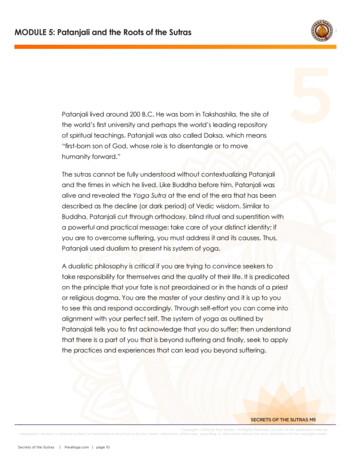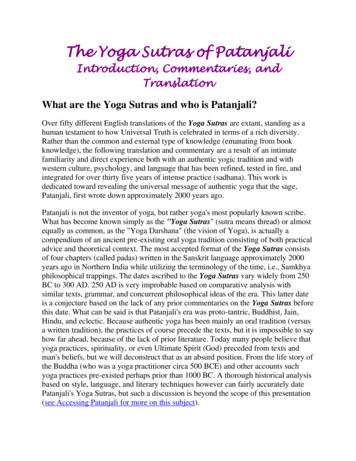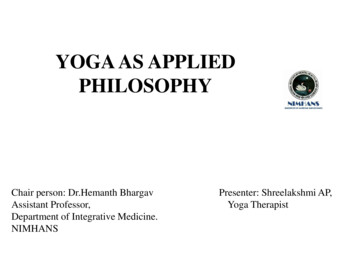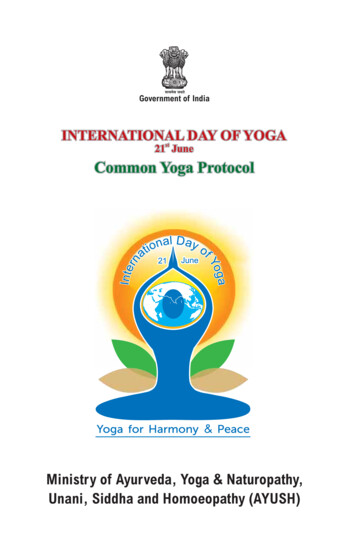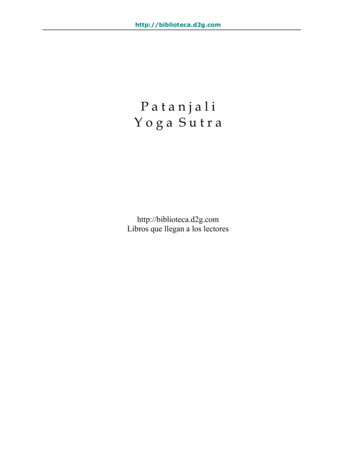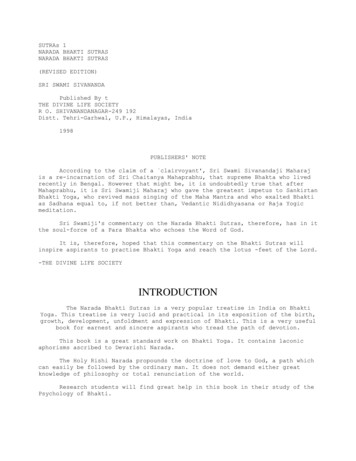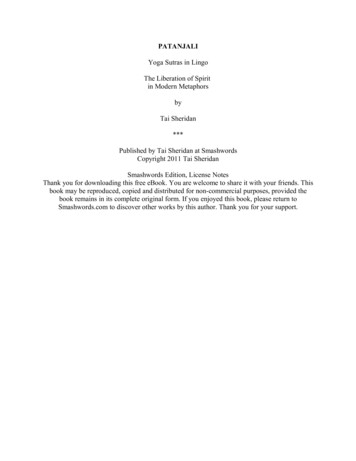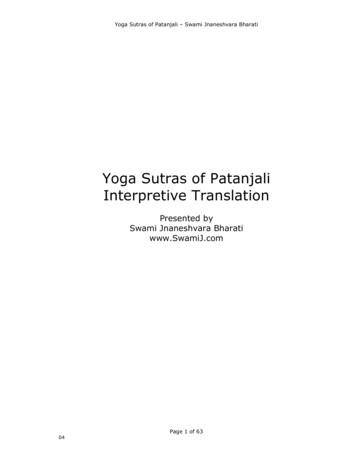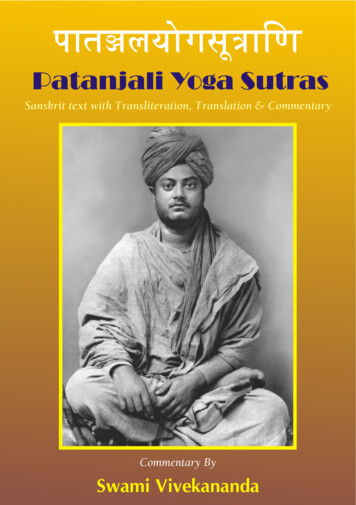
Transcription
Yoga Sutras of PatanjaliLiteral & Interpretive TranslationPresented byH.D. GoswamiTranslations by H.D. Goswami in bold blackTranslations by Barbara Stoler Miller – in “bold speechmarks”Translations by Chris Hartranft in bold italicTranslations by other scholars named thereinP a g e 1 47
Table of Contents of Yoga SutrasIntroduction . 3Chapter 1: Concentration (Samadhi Pada) . 4What is Yoga? (1.1-1.4) . 4Un-coloring your thoughts (1.5-1.11) . 4Practice and non-attachment (1.12-1.16) . 6Types of concentration (1.17-1.18) . 7Efforts and commitment (1.19-1.22) . 7Contemplation on AUM or OM (1.23-1.29) . 8Obstacles and solutions (1.30-1.32) . 10Stabilizing and clearing the mind (1.33-1.39) . 10After stabilizing the mind (1.40-1.51) . 12Chapter 2: Practices (Sadhana Pada). 14Minimizing gross colorings that veil the Self (2.1-2.9) . 14Dealing with subtle impressions that veil the Self (2.10-2.11) . 16Breaking the alliance of karma (2.12-2.25). 17The 8 rungs of Yoga are for discrimination (2.26-2.29) . 20Yamas and Niyamas, rungs #1 and #2 (2.30-2.34) . 21Benefits from the Yamas and Niyamas (2.35-2.45) . 22Asana or meditation posture, rung #3 of 8 (2.46-2.48) . 24Pranayama and breath control, rung #4 of 8 (2.49-2.53). 24Pratyahara or sense withdrawal, rung #5 of 8 (2.54-2.55). 25Chapter 3: Progressing (Vibhuti Pada). 26Dharana, Dhyana, Samadhi, rungs #6, #7, and #8 (3.1-3.3) . 26Samyama is the finer tool (3.4-3.6) . 26Internal is seen to be external (3.7-3.8) . 27Witnessing subtle transitions with Samyama (3.9-3.16). 27Divine Powers from Perfect Discipline (3.17-3.37) . 29What to do with subtle experiences (3.38) . 33More attainments from Samyama (3.39-3.49) . 33Renunciation that brings kaivalya or liberation (3.50-3.52) . 37Higher discrimination through Samyama (3.53-3.56). 38Chapter 4: Liberation (Kaivalya Pada) . 39Means of attaining experience (4.1-4.3) . 39Emergence and mastery of mind (4.4-4.6) . 40Actions and karma (4.7-4.8). 40Subconscious impressions (4.9-4.12) . 41Objects and the 3 gunas (4.13-4.14) . 42Mind perceiving objects (4.15-4.17) . 42Illumination of the mind (4.18-4.21). 43Buddhi, discrimination, and liberation (4.22-4.26). 44Breaches in enlightenment (4.27-4.28). 45Perpetual enlightenment (4.29-4.30) . 45Knowables become few (4.31) . 46Gunas and liberation or Kaivalya (4.32-4.34). 46P a g e 2 47
IntroductionThe Yoga Sutras of Patanjali succinctly outlines the art and science of Yoga meditation for Self Realization. It is a process of systematically encountering, exa mining, and transcending each of thevarious gross and subtle levels of false identity in the mind field, until the jewel of the true Selfcomes shining through.While some translations are literal others are interpretive translation to help present the meaningwith clarity. For example, sutra 1.2 defines Yoga with some 25 English words, rather than only 4Sanskrit words. The practices of the Yoga Sutras are extremely practical, though it can seem quitecomplicated when trying to sort through the language. By providing expanded, interpretivetranslations, the practical meaning of the suggestions more easily comes through. The individualtransliterated Sanskrit words also have a large number of English translations, so as to give a morethorough understanding.When Patanjali codified, or compiled the Yoga Sutras, it was not that a new system was created, butrather, the ancient practices were summarized in an extremely organized and terse way. While theYoga Sutras are thought to be as old as 400 BCE, archae ological, astronomical, meterologicalevidence and other texts suggest that the methods described in the Yoga Sutras were beingpracticed as early as 3000 BCE. Oral tradition states that the period may be even longer.Yoga means union. Yoga literally means to yoke, from the root yuj, which means to join; connectingtwo things together, connecting two people together, or even connecting two separateconsciousnesses together. Samadhi therefore is the complete state of absorption through yogaabsorption. Sutra means thread, and this thread, or multiple threads weave a tapestry ofphilosophical insight and direct experience of yogaThe Astangha Yoga system starting from Sutra 2.29 is the most commonly known sutra amongstmodern society, which delineates an 8-limbed yoga system starting from voluntarily followingobservances and self-restraints to get the yogi into a decent moral state, through which the mindbecomes peaceful and can focus on the practise of yoga, up to complete absorption in pureawareness, Samadhi. A clue is given by Patanjali in Sutra 2.45 that even when one has reached theperfect stage of Samadhi, the perfection of that perfect stage (samadhi-siddhir), is: isvarapranidhanat, devotion to the Supreme. It is uncommon to catch this point as Krishna explains in theBhagavad-Gita (7.19) that only a rare, magnanimous yogi catches this point after years and yearsof existences.P a g e 3 47
Chapter 1: Concentration (Samadhi Pada)WHAT IS YOGA? (1.1-1.4)1.1atha yoga anushasanamNow, instruction on yoga. 1.2yogash chitta vritti nirodhahYoga restrains the turnings of the mind. 1.3 tada then, at that time; at t he time of concentration and meditation drashtuh the seer's, of the soul, witness, Atman, Self; from the root drsh, which means tosee (It is significant to note that Patanjali is not trying to define who is the seer, or thenature of that seer. This is left to be answered or resolved in direct experience.) svarupe in its own nature, own form or essence; (sva own; rupa form) avasthanam stability, settling, remaining, being in a state, resting, standing, lying,abiding; the root stha means to stand vritti sarupyam itaratraOtherwise, the form of the mind’s turnings will be assumed. yoga of yoga, union; literally, to yoke, from the root yuj, which means to join; same asthe absorption in samadhi chitta of the consciousness of the mind-field vritti operations, activities, fluctuations, modifications, changes, or various forms of themind-field nirodhah coordination,understanding, stilling, quieting, setting aside of tada drashtuh svarupe avasthanamThen the seer stands firm in his own form.1.4 atha now, at this auspicious moment; implying the transition to this practice and pursuit,after prior preparation; implying a blessing at this moment of transition yoga of yoga, union; literally, to yoke, from the root yuj, which means to join or tointegrate; same as the absorption in samadhi anu within, or following tradition; implies being subsequent to something else, in thiscase, the prior preparation shasanam instruction, discipline, training, teaching, exposition, explanation; Shas impliesthe imparting of teaching that happens along with discipline vritti of the operations, activities, fluctuations, modifications, changes, or variousforms (of the mind-field) sarupyam similarity, assimilation, appearance of, identification of form or nature,conformity with the shape of; the root sa means with, and rupa means form itaratra elsewhere, at other times, when not in that state of realization above UN-COLORING YOUR THOUGHTS (1.5-1.11)1.5 vrittayah pancatayah klishta aklishtaThe mind’s turnings are five-fold, painful, or not painful. vrittayah the vrittis are P a g e 4 47
pancatayah five fold (and of two kinds); panch means five klishta colored, painful, afflicted, impure; the root klish means to cause trouble;(klesha is the noun form of the adjective klishta) aklishta uncolored, not painful, not afflicted, pure; not imbued with kleshas; the root ameans without or in the absence of; hence, without the coloring called klishta 1.6 pramana viparyaya vikalpa nidra smritayahJudging, misjudging, imagination, sleep, and memory. pramana real or valid cognition, right knowledge, valid proof, seeing clearly viparyayah unreal cognition, indiscrimination, perverse cognition, wrong knowledge,misconception, incorrect knowing, not seeing clearly vikalpah imagination, verbal misconception or delusion, fantasy, hallucination nidra deep sleep smritayah memory, remembering 1.7pratyaksha anumana agamah pramananiJudgments are [based on] perception, logic and authority. 1.8viparyayah mithya jnanam atad rupa pratisthamMisjudgment is a false awareness not based on the [real] form of a thing. pratyaksha direct perception or cognition anumana inference, reasoning, deduction agamah authority, testimony, validation, competent evidence pramanani valid means of knowing, proofs, sources of correct knowing 1.9viparyayah unreal cognition, indiscrimination, perverse cognition, wrong knowledge,misconception, incorrect knowing, not seeing clearly mithya of the unreal, of the false, erroneous, illusory jnanam knowing, knowledge atad not its own, not that rupa form, nature, appearance pratistham based on, possessing, established, occupying, steadfast, standing shabda jnana anupati vastu shunyah vikalpahDevoid of substance, imagination results from a [mere] awareness of words. shabda word, sound, verbal expression jnana by knowledge, knowing anupati following, in sequence, depending upon vastu a reality, real object, existent shunyah devoid, without, empty vikalpah imagination, verbal misconception or delusion, fantasy, hallucination 1.10abhava pratyaya alambana vritti nidraSleep is a turning [of the mind] unsupported by the recognition of an existing thing. abhava absence, non-existence, non-occurrence, negation, voidness, nothingness pratyaya the cause, the feeling, causal or cognitive principle, notion, content of mind,presented idea, cognition alambana support, substratum, leaning on, dependent on, having as a base or fo undation vritti operations, activities, fluctuations, modifications, changes, or various forms of themind-field P a g e 5 47
nidra deep sleep 1.11anubhuta vishaya asampramoshah smritihMemory [in this context] is not the clearing away [from the mind] of [previously]perceived objects. anubhuta experienced vishaya objects of experience, impressions asampramoshah not being stolen, not being lost, not having addition smritih memory, remembering PRACTICE AND NON-ATTACHMENT (1.12-1.16)1.12abhyasa vairagyabhyam tat nirodhahRestraint of these [turnings ofdetachment. 1.13 themind][comes]throughpracticeandabhyasa by or with practice, repeated practice vairagyabhyam non-attachment, by desirelessness or dispassion, neutrality or absence ofcoloring, without attraction or aversion tat of those, through that of nirodhah coordination,understanding, stilling, quieting, setting aside of tatra sthitau yatnah abhyasaPractice means effort in that [endeavor].tatra of these two (abhyasa and vairagya)sthitau stability, steadiness, stable tranquility, undisturbed calmnessyatnah effort, persistent exertion, sustained struggle, endeavourabhyasa by or with practice, repeated practice1.14sah tu dirgha kala nairantaira satkara asevitah dridha bhumihNow that [practice gains] firm ground when diligently and respectfully performedwithout interruption and for a long time. sah that (practice) tu and, but, however dirgha long time (dirgha long; kala time) nairantaira without interruption, continually, satkara with devotion, sincerity, respect, reverence, positive attitude, right action asevitah pursued, practiced, cultivated, attended to, done with assiduous attention dridha-bhumih stable, solid foundation, firmly rooted, of firm ground (dridha firm;bhumih ground) 1.15drista anushravika vishaya vitrishnasya vashikara sanjna vairagyamDetachment is defined as the control achieved by one who does not thirst afterobjects [personally] seen or heard about [from others]. drista seen, perceived anushravika revealed, scriptural, heard in tradition vishaya objects, subjects, matters of experience vitrishnasya of one who is free from desire or craving vashikara supreme, mastery, total control P a g e 6 47
sanjna awareness, consciousness, knowing vairagyam non-attachment, desirelessness, dispassion, neutrality or absence of coloring,without attraction or aversion 1.16tat param purusha khyateh guna vaitrshnyam)After that, through knowledge of the Person, one is freed of thirst for [material]qualities. tat that param is higher, superior, supreme, transcendent purusha pure consciousness, Self khyateh through knowledge, vision, discernment guna elements, prime qualities, constituents, attributes; (three gunas of sattvas,rajas, tamas) vaitrshnyam state of freedom from desire or craving (for the gunas) TYPES OF CONCENTRATION (1.17-1.18)1.17vitarka vichara ananda asmita rupa anugamat samprajnatah)By following reason, analysis, bliss, I-am-ness, and beauty, one achieves fullconsciousness. vitarka gross thought or reasoning vichara subtle thought ananda bliss, ecstasy asmita I-ness, individuality rupa appearances, nature, form anugamat accompanied by, associated with samprajnatah cognitive absorption, lower samadhi 1.18virama pratyaya abhyasa purvah samskara shesha anyahAnother comes to that consciousness first by the practice of trusting in thetermination [of material consciousness] and at the end through [actual] purification. virama cessation, stopping, receding pratyaya cause, cognitive principle, content of mind, cognition abhyasa practice purvah preceding, coming before samskara deep impressions, imprints in the unconscious, deepest habits, subliminalactivators, traces shesha residual, subliminal anyah the other (the other samadhi) EFFORTS AND COMMITMENT (1.19-1.22)1.19bhava pratyayah videha prakriti layanamFor those merged in disembodied nature (celestial nature), awareness of materialexistence. bhava objective existence, becomingpratyayah cause, cognitive principle, content of mind, cognitionvideha bodiless, disembodiedP a g e 7 47
prakriti creative cause, subtlest material cause, naturelayanam dissolved, merged into1.20shraddha virya smriti samadhi prajna purvakah itareshamFor others, [the method is] prioritizes faith, prowess, memory, trance andwisdom. 1.21 shraddha unconditional faith, trust, confidence, belief, certainty virya energy, strength of will smriti memory, intentful remembrance, mindfulness samadhi deep absorption of meditation, entasy prajna wisdom, discernment, super cognitive purvakah preceding, coming before, prerequisite itaresham of other people tivra samvega asannahFor the extremely intense, it is near.tivra rate is fast, speedy samvega momentum, force, vigor, conviction, enthusiasm asannah very close, near, speedy 1.22mridu madhya adhimatra tatah api visheshahHow near depends on whether the practice is mild, moderate, or intense. [ChrisHartranft] mridu mild, slow madhya medium, middling adhimatra intense, strong tatah from that api also visheshah differentiation, distinction CONTEMPLATION ON AUM OR OM (1.23-1.29)1.23 ishvara-pranidhanad vaOr [wisdom is achieved] through devoted meditation on the Lord.ishvara creative source, pure consciousness, purusha, God, supreme Guru or teacherpranidhana practicing the presence, sincerity, dedication, devotion, surrender offruits of practiceva or1.24klesha karma vipaka ashayaih aparamristah purusha-vishesha ishvaraThe Lord is a distinct person untouched by trouble, karma,consequences and conditioning. materialklesha colored, painful, afflicted, impure; the root klish means to cause trouble karma actions, vipaka fruits of, maturing, ripening P a g e 8 47
1.25 1.26 1.27 1.28 1.29 ashayaih by the vehicles, resting place, storage of traces, propensities,accumulations aparamristah untouched, unsmeared purusha-vishesha a consciousness, a special or distinct purusha (purusha aconsciousness; vishesha special, distinct) ishvara creative source, God, supreme Guru or teacher tatra niratishayam sarvajna bijamThere [in Him] is the unexcelled seed of omniscience.tatra there, in that (in that special purusha)niratishayam unsurpassed, not exceeded by any others, limitlesssarvajna all knowing (sarva all; jna knowing)bijam seedpurvesham api guruh kalena anavachchhedatBecause He is not limited by time, He is the guru even of the ancients.purvesham of the first, former, earlier, ancientapi too, alsoguruh teacherkalena by timeanavachchhedat not limited by (time), no break or division, continuoustasya vachakah pranavahHis speaking is the syllable Om.tasya of that vachakah designator, signifier, indicator, term pranavah the mantra AUM or OM tat japah tat artha bhavanamIts soft chanting manifests its meaning.tat itsjapah repeated remembrancetat itsartha meaningbhavanam understanding with feeling, absorbing, dwelling upontatah pratyak chetana adhigamah api antaraya abhavash chaFrom this one actually attains internal awareness, and obstacles cease to exist.tatah thence pratyak individual chetana consciousness adhigamah understanding, realization, attainment api also antaraya of obstacles or impediments abhavash absence, disappearance, removal cha and, also P a g e 9 47
OBSTACLES AND SOLUTIONS (1.30-1.32)1.30 vyadhi styana samshaya pramada alasya avirati bhranti- darshana alabdha-bhumikatvaanavasthitatva chitta vikshepa te antarayahThese are the obstacles that distract the mind: disease, apathy, doubt,carelessness, laziness, lack of detachment, erroneous vision, not achieving a groundedposition, and unsteadiness. vyadhi disease, illness, sickness styana mental laziness, inefficiency, idleness, procrastination, dullness samshaya indecision, doubt pramada carelessness, negligence alasya sloth, languor, laziness avirati sensuality, want of non-attachment, non-abstention, craving bhranti-darshana false views or perception, confusion of philosophies (bhranti false; darshana views, perception) alabdha-bhumikatva failing to attain stages of practice (alabdha not obtaining;bhumikatva stage, state, firm ground) anavasthitatva instability, slipping down, inability to maintain chitta-vikshepa distractions of the mind (chitta mind field; vikshepa distractions,diversions) te they are, these are antarayah obstacles, impediments 1.31duhkha daurmanasya angam-ejayatva shvasa prashvasah vikshepa sahabhuvaMisery, melancholy, bodily trembling and troubled breathing accompany thesedistractions. 1.32 duhkha pain (mental or physical) daurmanasya sadness, despair, dejection, frustration, depression, anguish angam-ejayatva shakiness, unsteadiness, movement, tremor of the limbs or body (anga limbs or body) shvasa inhalation, inspiration (implying irregular inhalation) prashvasah exhalation, expiration (implying irregular exhalation) vikshepa distractions sahabhuva companions, accompaniments, correlates tat pratisedha artham eka tattva abhyasahTo ward off these distractions, there is practice of one truth.tat those, their pratisedha prevention, negation, neutralizing, prohibition, opposing, voiding, removal artham for, for the purpose of, in order to eka single, tattva truth, principle, subject, reality abhyasah practice, cultivating that habit STABILIZING AND CLEARING THE MIND (1.33-1.39)1.33 maitri karuna mudita upekshanam sukha duhka punya apunya vishayanam bhavanatahchitta prasadanamClarity and peace of mind come from mentally cultivating friendship with thehappy, mercy toward the unhappy, joy in piety and neglect of impiety.P a g e 10 47
1.34 1.35 maitri friendliness, pleasantness, lovingness karuna compassion, mercy mudita gladness, goodwill upekshanam acceptance, equanimity, indifference, disregard, neutrality sukha happy, comfortable, joyous duhka pain, misery, suffering, sorrow punya virtuous, meritorious, benevolent apunya non-virtuous, vice, bad, wicked, evil, bad, demerit, non-meritorious, vishayanam regarding those subjects, in relation to those objects bhavanatah by cultivating habits, by constant reflection, developing attitude, cultivating,impressing on oneself chitta mind field, consciousness prasadanam purified, clear, serene, pleasant, pacified, undisturbed, peaceful, calm prachchhardana vidharanabhyam va pranayamaOr [it comes] from the expulsion and retention of breath.prachchhardana gentle exhalation through the nostrils vidharanabhyam expansion or regulation, control va or (or other practices in 1.34-1.39) pranasya of prana vishayavati va pravritti ut panna manasah sthiti nibandhaniOr by holding the mind in place when object-based activity arises.vishayavati of the sensing experience va or (or other practices in 1.34-1.39) pravritti higher perception, activity, inclinations utpanna arising, appearing, manifesting manasah mind, mental, manas sthiti stability, steadiness, stable tranquility, undisturbed calmness nibandhani firmly establishes, causes, seals, holds 1.36vishoka va jyotishmatiOr [when such] activity is sorrowless, illuminating. 37. Or when the mind [has]objects free of passion. 1.37 1.38vishoka state free from pain, grief, sorrow, or sufferingva or (or other practices in 1.34-1.39)jyotishmati the bright effulgence, lucidity, luminosity, inner light, supreme or divine lightvita raga vishayam va chittamOr when the mind [has] objects free of passion.vita without, devoid of raga attachment, desires, attraction vishayam objects of the senses va or (or other practices in 1.34-1.39) chittam of the consciousness of the mind-field svapna nidra jnana alambanam vaOr [when the mind rests on] knowledge from dreams and sleep.P a g e 11 47
1.39 svapna dream (focusing on the nature of the state of dreaming itself, not the content ofdreams) nidra sleep (focusing on the state itself, as an object) jnana knowledge, study, investigation, awareness, observation alambanam having as support for attention, object of concentration va or (or other practices in 1.34-1.39) yatha abhimata dhyanat vaOr from meditation according to preference.yatha as, according to abhimata one's own predisposition, choice, desire,agreeableness dhyanat meditate on va or (or other practices above in sutras 1.34-1.39) want,like,familiarity,AFTER STABILIZING THE MIND (1.40-1.51)1.40parma-anu parama-mahattva antah asya vashikarahOne [whose mind is clear and tranquil] has mastery from the smallest particle tothe greatest. parma-anu from the minutest (parma most; anu minutest, smallest) parama-mahattva ultimate magnitude (parama ultimate, maximum; mahattva infinity, largeness magnitude) antah end, extending to asya of this, of his or hers (who has vashikarah mastery, power 1.41 kshinna-vritti abhijatasya iva maneh grahitri grahana grahyeshu t at-stha tat-anjanatasamapattihWhen the turnings decrease [in a mind] which [has become] like an excellentjewel, then in the perceiver, the perceiving and the perceived there is a coloring [of themind] by that which stands near. [This is] samäpatti, accomplished meditation. kshinna-vritti with modifications of mind weakened (kshinna weakened; vritti modifications of mind) abhijatasya transparent, purified iva like maneh of a crystal grahitri the knower, apprehender, observer grahana process of knowing or apprehending, instrument of knowing grahyeshu the knowable, knowledge, apprehended objects tat-stha remaining in it, being stable on them, on which it stays or rests tat-anjanata taking on the coloring of that, coalescing with, appearing to take theshape of the object samapattih engrossment, coincidence, complete absorption, transmute into likeness,total balance 1.42tatra shabda artha jnana vikalpah sankirna savitarka samapattihIn that state, when samäpatti is filled with imaginings based on knowledge ofword-meanings, it is [called] accomplished meditation with speculative doubts. tatra there, among these, in that shabda sound, word artha meaning P a g e 12 47
jnana knowledge, idea vikalpah with options sankirna mixed with, commingled, interspersed savitarka accompanied with gross thoughts (sa with; vitarka gross thoughts) samapattih engrossment, coincidence, complete absorption, transmute into likeness 1.43 smriti pari-shuddhau svarupa-shunya iva artha-matra nirbhasa nirvitarkaWhen memory is fully purified, and only the object [of perception] shines forth,then one’s accomplished meditation is devoid of its own identity, without speculativedoubts. smriti of memory pari-shuddhau upon purification (pari upon; shuddhau purification) svarupa-shunya devoid of its own nature (shunya devoid; svarupa its own nature) iva as it were artha-matra only the object (artha object; matra only) nirbhasa illuminative, shining brightly nirvitarka without a gross thought (nir without; vitarka gross thought) 1.44etaya eva savichara nirvichara cha sukshma-vishaya vyakhyataBy this alone, accomplished meditation with and without reflection, with a subtleobject, is explained. etaya by this eva also savichara accompanied by subtle thought s (sa with; vichara subtle thoughts) nirvichara devoid of subtle thoughts (nir without; vichara subtle thoughts) cha and sukshma-vishaya having subtle for their objects (sukshma subtle; vishaya objects) vyakhyata are explained, described, defined 1.45 1.46 1.47 sukshma vishayatvam cha alinga paryavasa
transliterated Sanskrit words also have a large number of English translations, so as to give a more thorough understanding. When Patanjali codified, or compiled the Yoga Sutras, it was not that a new system was created, but rather, the ancient practices were summ
